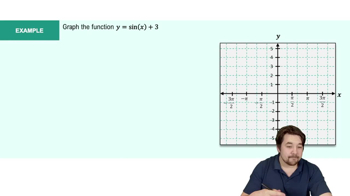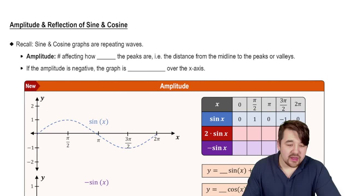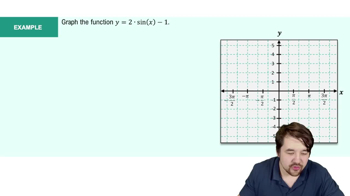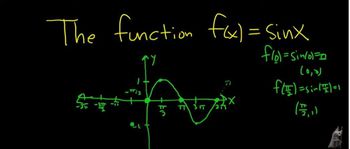Table of contents
- 0. Review of College Algebra4h 43m
- 1. Measuring Angles39m
- 2. Trigonometric Functions on Right Triangles2h 5m
- 3. Unit Circle1h 19m
- 4. Graphing Trigonometric Functions1h 19m
- 5. Inverse Trigonometric Functions and Basic Trigonometric Equations1h 41m
- 6. Trigonometric Identities and More Equations2h 34m
- 7. Non-Right Triangles1h 38m
- 8. Vectors2h 25m
- 9. Polar Equations2h 5m
- 10. Parametric Equations1h 6m
- 11. Graphing Complex Numbers1h 7m
4. Graphing Trigonometric Functions
Graphs of the Sine and Cosine Functions
Problem 4.27c
Textbook Question
Each function graphed is of the form y = c + cos x, y = c + sin x, y = cos(x - d), or y = sin(x - d), where d is the least possible positive value. Determine an equation of the graph.
<IMAGE>
 Verified step by step guidance
Verified step by step guidance1
<Examine the graph to identify the type of trigonometric function: cosine or sine.>
<Determine the vertical shift 'c' by observing the midline of the graph.>
<Identify the phase shift 'd' by finding the horizontal shift from the standard position of the cosine or sine function.>
<Write the equation in the form y = c + cos(x - d) or y = c + sin(x - d) based on your observations.>
<Verify the equation by checking if it matches the key features of the graph, such as amplitude, period, and phase shift.>
Recommended similar problem, with video answer:
 Verified Solution
Verified SolutionThis video solution was recommended by our tutors as helpful for the problem above
Video duration:
0m:0sPlay a video:
Was this helpful?
Key Concepts
Here are the essential concepts you must grasp in order to answer the question correctly.
Trigonometric Functions
Trigonometric functions, such as sine and cosine, are periodic functions that describe relationships between angles and sides in right triangles. They oscillate between -1 and 1, and their graphs exhibit a wave-like pattern. Understanding these functions is crucial for analyzing their transformations and shifts, which are central to the question.
Recommended video:

Introduction to Trigonometric Functions
Vertical and Horizontal Shifts
Vertical and horizontal shifts refer to the transformations applied to the basic sine and cosine functions. A vertical shift occurs when a constant is added or subtracted from the function, moving it up or down. A horizontal shift, indicated by the parameter 'd' in the equations, moves the graph left or right, affecting the starting point of the wave.
Recommended video:
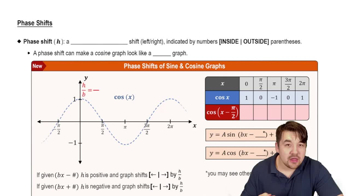
Phase Shifts
Phase Shift
Phase shift is the horizontal displacement of a periodic function, determined by the value of 'd' in the equations y = cos(x - d) or y = sin(x - d). It indicates how much the graph is shifted along the x-axis. Understanding phase shifts is essential for accurately determining the equation of the graph based on its position relative to the standard sine and cosine functions.
Recommended video:

Phase Shifts

 5:53m
5:53mWatch next
Master Graph of Sine and Cosine Function with a bite sized video explanation from Nick Kaneko
Start learningRelated Videos
Related Practice



